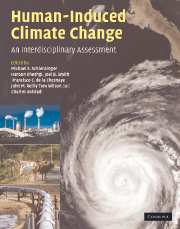Book contents
- Frontmatter
- Contents
- List of contributors
- Preface
- Part I Climate system science
- 1 The concept of climate sensitivity: history and development
- 2 Effect of black carbon on mid-troposphere and surface temperature trends
- 3 Evaluating the impacts of carbonaceous aerosols on clouds and climate
- 4 Probabilistic estimates of climate change: methods, assumptions and examples
- 5 The potential response of historical terrestrial carbon storage to changes in land use, atmospheric CO2, and climate
- 6 The albedo climate impacts of biomass and carbon plantations compared with the CO2 impact
- 7 Overshoot pathways to CO2 stabilization in a multi-gas context
- 8 Effects of air pollution control on climate: results from an integrated global system model
- Part II Impacts and adaptation
- Part III Mitigation of greenhouse gases
- Part IV Policy design and decisionmaking under uncertainty
- Index
- Plate section
- References
5 - The potential response of historical terrestrial carbon storage to changes in land use, atmospheric CO2, and climate
from Part I - Climate system science
Published online by Cambridge University Press: 06 December 2010
- Frontmatter
- Contents
- List of contributors
- Preface
- Part I Climate system science
- 1 The concept of climate sensitivity: history and development
- 2 Effect of black carbon on mid-troposphere and surface temperature trends
- 3 Evaluating the impacts of carbonaceous aerosols on clouds and climate
- 4 Probabilistic estimates of climate change: methods, assumptions and examples
- 5 The potential response of historical terrestrial carbon storage to changes in land use, atmospheric CO2, and climate
- 6 The albedo climate impacts of biomass and carbon plantations compared with the CO2 impact
- 7 Overshoot pathways to CO2 stabilization in a multi-gas context
- 8 Effects of air pollution control on climate: results from an integrated global system model
- Part II Impacts and adaptation
- Part III Mitigation of greenhouse gases
- Part IV Policy design and decisionmaking under uncertainty
- Index
- Plate section
- References
Summary
Introduction
Modeling and measurement studies indicate that ocean and land ecosystems are currently absorbing slightly more than 50% of the human CO2 fossil emissions (Prentice et al., 2001). However, a significant question remains regarding the sources and sinks of carbon over land governed by changes in land covers and physiological processes that determine the magnitude of the carbon exchanges between the atmosphere and terrestrial ecosystems. Most of these processes are sensitive to climate factors, in particular temperature and available soil water (Post et al., 1997). It is also likely that these processes are sensitive to changes in atmospheric CO2. Moreover, the climate variation is not uniformly distributed throughout the Earth's surface or within ecosystem types. Therefore, simulations of terrestrial carbon storage must take into account the spatial variations in climate as well as non-climate factors that influence carbon storage, such as land-cover type and soil water holding capacity, that interact with climate. Estimates should also account for land-cover changes with time. Because the changes in land cover, mainly from forest to croplands or forest to pasturelands, shorten the turnover of carbon above and below ground, they act to reduce the sink capacity of the biosphere.
Historical changes in biospheric carbon storage and exchange with the atmosphere are commonly simulated with globally aggregated biospheric models (Jain et al., 1996; Kheshgi and Jain, 2003), mostly in response to changes in atmospheric CO2 and climate, or changes in land-cover types (Houghton and Hackler, 2001; Houghton, 2003).
- Type
- Chapter
- Information
- Human-Induced Climate ChangeAn Interdisciplinary Assessment, pp. 62 - 71Publisher: Cambridge University PressPrint publication year: 2007



